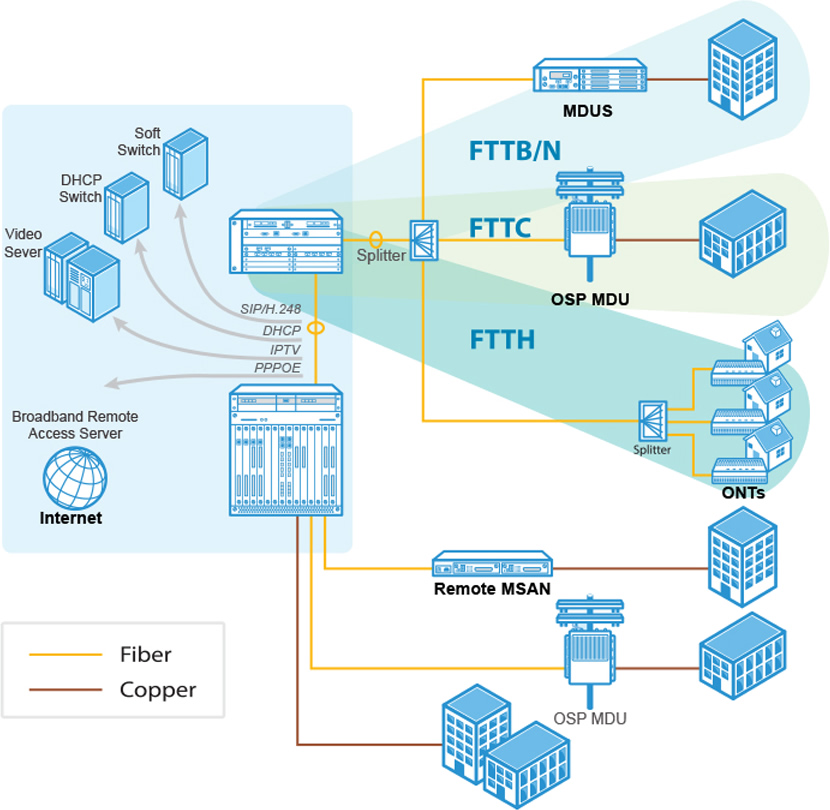What is EPON and GPON?
2020/3/27 10:17:53
The technology of GPON (Gigabit capable PON) is the latest generation of broadband passive optical integrated access standard based on itu-tg.984. X standard. It has many advantages, such as high bandwidth, high efficiency, wide coverage, rich user interface and so on. It is regarded by most operators as the ideal technology to realize the broadband and integrated transformation of access network services.

What is EPON
At present, IP / Ethernet Applications account for more than 95% of the whole LAN communication. EPON has become the most effective communication method to connect the end users of access network because of its economic and efficient structure. With the appearance of 10Gbps Ethernet backbone and man ring, EPON will become the best last kilometer solution in the future all optical network.
In an EPON, without any complex protocol, the optical signal can be accurately transmitted to the end user, and the data from the end user can also be centrally transmitted to the central network. In the physical layer, EPON uses the Ethernet PHY of 1000base, and in the transmission mechanism of PON, it controls and optimizes the burst data communication and real-time TDM communication between each optical network unit (ONU) and optical line terminal (OLT) through the newly added MAC control command. In the second layer of the protocol, EPON uses mature full duplex Ethernet technology and TDM, because ONU sends in its own time slot Send datagram, so there is no collision and CDMA / CD is not needed, so the bandwidth is fully utilized. In addition, EPON provides QoS similar to APON / GPON by implementing 802.1p in MAC layer.
Comparison between EPON and GPON
EPON aims to be compatible with the current Ethernet technology, is the continuation of 802.3 protocol in the optical access network, fully inherits the advantages of Ethernet, such as low price, flexible protocol, mature technology, etc., and has a wide market and good compatibility. GPON is oriented to the demand of multi service and QoS guaranteed full service access in the telecom industry. It strives to find an optimal solution that supports full service and has the highest efficiency, and puts forward "completely and thoroughly reconsidering all protocols open".
The technical features of EPON are as follows:
1)Ethernet is the best carrier of IP services;
2) easy to maintain, expand and upgrade;
3) EPON equipment is mature and available, EPON has laid millions of lines in Asia, the third generation of commercial chips has been launched, and the prices of relevant optical modules and chips have been greatly reduced, reaching the level of scale commercial, which can meet the requirements of broadband services in the near future; 4) EPON protocol is simple, low cost and low equipment cost. In man access network, the most appropriate technology is needed instead of the best technology; 5) it is more suitable for China, man has no equipment burden of ATM or BPON; 6) it is more suitable for the future, IP carries all services, Ethernet carries IP services.
The technical features of GPON are as follows:
1) access network for telecommunication operation;
2) high bandwidth: line rate, 2.488gb/s for downlink and 1.244gb/s for uplink; 3) high transmission efficiency: 94% for downlink (the actual bandwidth is up to 2.4G), 93% for uplink (the actual bandwidth is up to 1.1g); 4) full service support: g.984. X standard strictly defines the full service (voice, data and video) supporting telecommunication level; 5) Strong management ability: it has rich functions, reserved sufficient OAM domain in frame structure, and formulated OMCI standard; 6) high service quality: Multiple QoS levels, which can strictly guarantee the bandwidth and delay requirements of services; 7) low comprehensive cost: long transmission distance, high optical split ratio, effectively apportioning OLT cost, and reducing user access cost.
What's the difference between GPON and EPON
1.GPON originated from the early apon \ BPON technology of optical fiber communication, so it has developed into ATM frame format. EPON e refers to the Internet Ethernet, so EPON is required to be able to connect with the Internet directly and seamlessly at the beginning of its birth, so EPON code flow is the frame format of Ethernet. Of course, in order to adapt to the transmission on optical fiber, a layer of frame format defined by EPON is included outside the frame format of Ethernet frame.
2. The standard of EPON is IEEE 802.3ah. The basic principle for IEEE to formulate EPON standard is to standardize EPON in 802.3 architecture as much as possible, and expand MAC protocol of standard Ethernet as much as possible.
3.The standard of GPON is ITU-TG.984 series standard. The formulation of GPON standard considers the support for traditional TDM service, and continues to adopt 125ms fixed frame structure to maintain 8K timing continuity. In order to support ATM and other multi protocol, GPON defines a new encapsulation structure gem: gponencapsulationmethod. The data of ATM and other protocols can be mixed and packaged into frames.
4. In application, GPON has a larger bandwidth than EPON. It has a more efficient service bearer and a stronger light splitting capability. It can transmit a larger bandwidth service, realize more user access, pay more attention to multi service and QoS assurance, but the implementation is more complex. This leads to a higher cost than EPON. However, with the large-scale deployment of GPON technology, the cost difference between GPON and EPON is gradually narrowing.
5.Comparison of GPON and EPON protocol stacks

Summary:
EPON and GPON have their own advantages. GPON is better than EPON in terms of performance index, but EPON has advantages in time and cost. Looking forward to the future broadband access market, it may not be who replaces who, but should coexist and complement each other. For bandwidth, multi service, high QoS and security requirements and ATM technology as backbone network



